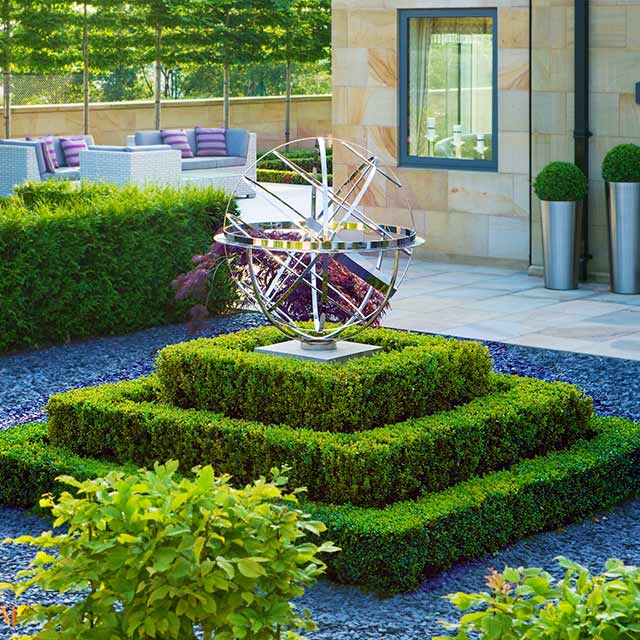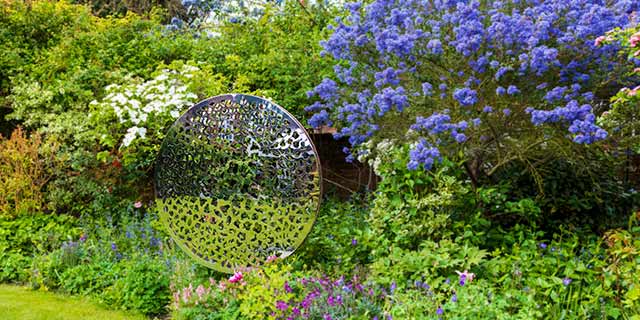Outdoor Sculpture for Small Spaces

There are no rules for choosing outdoor sculpture for small spaces. An artwork should add to or complement the space or planting around it. And you should like it. And that’s about it. Big can work. So can small. Modern, traditional, in the centre, off to one side, nestled in a border… All can beautify small gardens. What works all depends on the style and layout of the space.
Below, we outline some of the considerations that you can bring to bear on sculpture choice for a smaller space.
Where to put sculpture in small gardens?
When you haven't got a lot of space, finding a spot for outdoor artwork can seem tricky. In fact, there are quit a lot of options.
- Perhaps the most obvious position is right in the middle – and that can work well in a limited space. In formal or courtyard gardens for example, traditional style or regularly shaped contemporary artwork in the middle of a circle of stone and/or low hedging and/or planting can create a strong structure for a space.
- Then again, some sculptures, maybe not the largest, can add interest to an expanse of lawn.
- A popular place for sculptures is at the end of a path if you have one, creating an interesting destination to a stroll along the path.
- The centre of a garden is not the only place for a focal point. A judiciously placed interesting sculpture can distract from an eyesore; or it can help to lead the eye through all of a garden as one of a series of focal points.
- Many styles of sculpture will look good nestled in borders, adding interest to uninterrupted planting. The sculptural piece could be small, to be discovered on exploration; or it could be taller and stand out distinctly even from a distance.
- Another option is to put artwork on a garden wall, allowing the art to be enjoyed without infringing on limited living or planting space. An unusual example would be a wall sundial. They look lovely and would be an interesting surprise in a small garden – though they do need to face South or nearly South in order to tell the time. Water walls could also work well up against a garden border.
- Another point to bear in mind is whether a sculpture can be seen from inside. One of the great benefits of outdoor sculpture is its winter presence. When all around is dead (apart from evergreens of course), a strong sculptural statement is a welcome sight.
Filium sphere at the end of a path, vertical sundial on wooden boundary fence, Mimeo water feature nestled in planting, Chalice water feature in circular paving as centrepiece.




Which size is best for small garden artwork?
Big, as mentioned above, can work. But be reasonable. Michelangelo’s David would look silly towering above a small urban patch.
If you would like a large, impressive piece, consider how a large sculpture would fit into your garden.
A big, solid sculpture placed centrally may block the light or hide too much of the garden beyond. This may not be the case if a sculpture is light and airy. Placing a piece to one side may work better, as in the hero image at the top of this page of Nyneve in our 2018 Chelsea Flower show show garden.
The key size consideration is to ensure that an artwork is proportional to its surrounding. A too small piece in the plant borders may never be found; too big in a low border and a sculpture will tower unpleasantly above its companions.
Conversely, too small a sculpture as a focal point may look underwhelming and even a little bit foolish.
The size needs to be just right – and that is really a matter of judgement.
Large Torus sculpture to one side of a roof terrace, creating a splash without blocking.

What style of outdoor sculpture?
Once again, decisions about style need to take garden context into account.
- One option is to match a sculpture's style to that of your garden or house: choosing a contemporary piece with strong, clean lines for a modern space, for example; or, among more naturalistic planting, placing a "rusty" Corten® steel sculpture – which looks more "natural" than some materials; or using a traditional piece like an armillary sphere sundial for an old house or classically planted garden.
- You can also be more playful with style. Take the photo of an armillary sphere below. It's a sundial, which is traditional. But it is also made of shiny stainless steel, which feels contemporary. Then again, the armillary is placed on a plinth, which is a traditional position for sculptures. But the plinth is made of stepped hedging which feels surprising and very modern. The overall effect is quirky and fresh, fitting perfectly into a contemporary setting In other words, don't feel too limited by the style of your garden or house. Think through the effect and quite surprising pairings may be possible.
- Artwork can complement planting. David Harber often uses materials that harmonise well outside: natural looking "rusty" brown oxidised steel once again, and the blue-green verdigris finish often used on bronze. Heather blue irregular Welsh slate or river washed puddle stones – both used in our Dark Planet stone sphere - and other organic looking stones also integrate well outside. There's a photo of a Dark Planet Another complementary option is sculpture that imitates nature like our Quiver – looking the same but different. Surprisingly, reflective stainless steel sculptures can also complement planting in a different way, by reflecting back the colours as is vividly and gloriously the case in the photo below of Steel Breeze in a sunny, floriferous border.
- Go for contrast – for example bold shapes and/or strong colours that act as a foil to the froth of flowers. This can be harder to do well and often works best when the contrast isn’t too extreme. But a well paired contrast can create an exciting splash when it work out. The photo above of a Filium sphere painted shocking pink inside/verdigris armillary in a meadow illustrates the concept.
Armillary sphere looking modern, reflections off the stainless steel Steel Breeze merging with planting, Dark Planet sphere in grass, Quiver leaf sculpture fitting in with flowers






